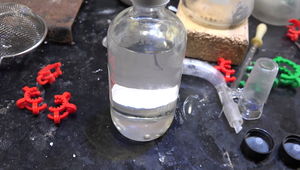Dimethyl dioxane
 Dimethyl dioxane prepared from propylene glycol
| |
| Names | |
|---|---|
| IUPAC name
2,5-Dimethyl-1,4-dioxane
| |
| Other names
3,6-Dimethyl-1,4-dioxane
Dimethyl-1,4-dioxane Dimethyl p-Dioxane Dimethyldioxane | |
| Properties | |
| C6H12O2 | |
| Molar mass | 116.16 g/mol |
| Appearance | Colorless liquid |
| Odor | Ether-like |
| Density | 0.932 g/cm3 (20 °C)[1] |
| Melting point | −4.5 °C (23.9 °F; 268.6 K) [2] |
| Boiling point | 116.5–121 °C (241.7–249.8 °F; 389.6–394.1 K) |
| Immiscible | |
| Solubility | Miscible with organic solvents |
| Hazards | |
| Safety data sheet | None |
| Flash point | 23.9 °C (75 °F; 297 K) |
| Related compounds | |
| Related compounds
|
Dioxane |
| Except where otherwise noted, data are given for materials in their standard state (at 25 °C [77 °F], 100 kPa). | |
| Infobox references | |
Dimethyl dioxane (IUPAC: 2,5-Dimethyl-1,4-dioxane) is an organic compound, an ether with the chemical formula C6H12O2. It is commonly encountered as a mixture of cis and trans isomers.
Contents
[hide]Properties
Chemical
Dimethyl dioxane is highly susceptible to acid catalyzed hydrolysis. A strong acid, like conc. sulfuric acid will cause it to break down into propylene glycol and other side products. On the other hand, bases, like sodium hydroxide do not hydrolyze dimethyldioxane to any appreciable degree.
Reducing mixtures, like zinc dust in ethanol or acetic acid will cleave dimethyldioxane.
Dimethyldioxane will form an addition compound with mercury(II) chloride[3]
Physical
Dimethyl dioxane is a colorless liquid, with an ether-like odor. It is immiscible with water, but miscible with other organic solvents.
Availability
There doesn't appear to be any chemical suppliers that sells this chemical. Best to make it yourself.
Preparation
Dimethyldioxane can be prepared by acid-catalyzed dehydration of propylene glycol. This can be done by adding a small amount of concentrated sulfuric acid to pure propylene glycol and distilling off the product. Remove the water from the distillate using a separatory funnel, then transfer the ether into a flask. To destroy all impurities, you cannot use acid, like in the case of dioxane, as dimethyldioxane is sensitive to acids. Instead, a base like sodium or potassium hydroxide should be used. Add the base flakes to the dimethyldioxane, then stir the product for a few hours to make sure all the impurities will polymerize. After all the impurities have polymerized, the final product should be reddish in color. To get a purer product, you can fractionally distill the ether, and collect the fraction boiling between 117-120 °C.[4]
For this process to work, you will need pure propylene glycol. Any impurities will poison the reaction, so it's best to distill the propylene glycol first.
Another route involves passing propylene oxide through a layer of bentonite with acidic centers. Reaction takes place in butanol, at 50 °C, at reduced pressure (0.01-0.02 at)[5]
Projects
- Liquid-liquid extractions
Handling
Safety
There is very little data about the toxicity of this chemical compound.
Storage
Like most ethers, dimethyl dioxane will slowly form explosive peroxides in storage, though addition of a small amount of butylated hydroxytoluene (BHT) or storage over sodium metal will prevent the formation of peroxides. Sodium hydroxide can also be used. Care must be taken not to distill the ether to dryness due to the trace amounts of peroxides formed over time.
Disposal
Dimethyl dioxane can be safely burned, unless it has peroxides. If the ether tests positive for peroxides but there is no precipitate in the ether, it's possible to neutralize the dissolved peroxides. Reducing agents, like ferrous sulfate, sodium bisulfite or metabisulfite added in excess can be used to neutralize the peroxides. After neutralization, the ether should be tested again for peroxides and if none are present, it can be safely burned.
If it's an old bottle, which has visible peroxide in the solution, or if very old, is very likely to have peroxides on the cap, DO NOT OPEN THE BOTTLE! Instead take it to a remote of special area and safely detonate it. The latter may or may not require professional help, depending on the severity of the case.
References
- Jump up ↑ Summerbell et al.; Journal of Organic Chemistry; vol. 27; (1962); p. 4365,4367
- Jump up ↑ http://actachemscand.org/pdf/acta_vol_09_p1237-1238.pdf
- Jump up ↑ http://actachemscand.org/pdf/acta_vol_09_p1237-1238.pdf
- Jump up ↑ https://www.youtube.com/watch?v=Soc4uR6Zpc4
- Jump up ↑ Zeiberlikh, F. N.; Lukoyanova, T. P.; Rogushina, T. K.; Korotkova, N. P.; Gladush, L. P.; Simenido, A. V.; J. Appl. Chem. USSR (Engl. Transl.); vol. 62; nb. 7.2; (1989); p. 1563 - 1567,1446 - 1450